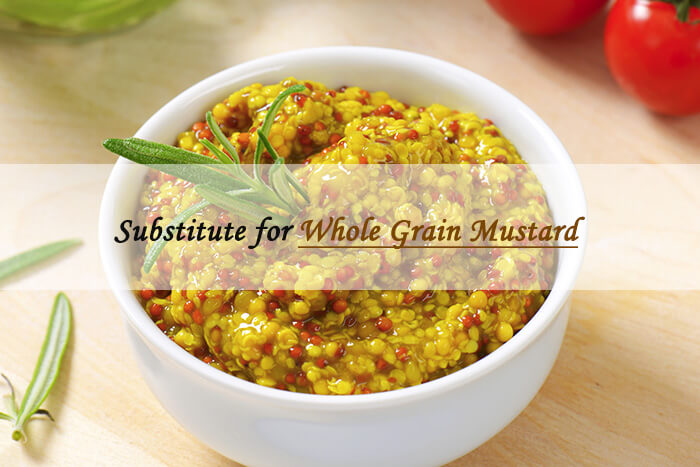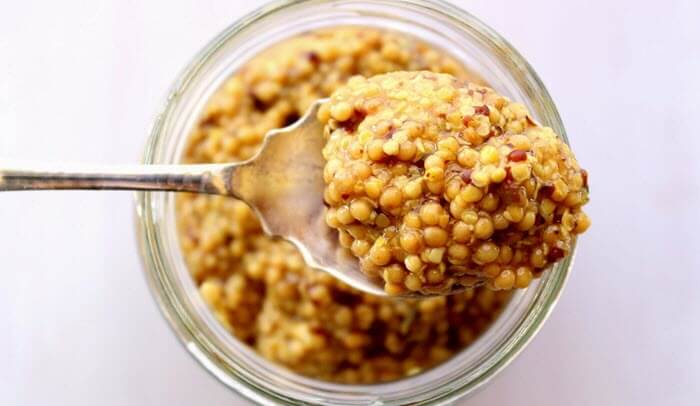Whole grain mustard has been a common part of many peoples’ diets for centuries. Archeological evidence from the Indus River Valley suggests humans were consuming the punchy condiment as early as 1850 B.C.E.
That’s hardly surprising given the seed’s distinctive flavor and health benefits. The superfood is known to relieve aches and pains as well as improve respiratory and heart health, according to randomized controlled trials published in the Clinical Trials Journal.
Today, you can explore many modern variations on traditional mustard, which we’ll outline for you in this article.
Table Of Contents
What Is A Whole Grain Mustard?
Whole grain mustard is just a type of mustard where the seeds are left intact. This is in contrast with more refined mustards, where the seeds are ground down into a paste.
The result is a stronger and more distinctive flavor than yellow mustards or other alternatives. Whole grain mustards also tend to have fewer additives than processed products.
For many, the varied texture is also an appeal. The characteristic crunch of individual seeds can add an element of interest to a dish.
What’s a Good Whole Grain Mustard Substitute?
While whole grain mustard is popular for a reason, there are a lot of substitutes you can try. Each has its distinct flavor profile.
1. Dijon Mustard
Perhaps the most famous mustard variety, Dijon mustard originates in the Dijon region of France, where it has been produced since 1856. If you’re buying it today, there’s a good chance it was made somewhere else.
You can get Dijon mustard in a whole grain or paste variety. Its distinctive characteristic is that it’s made with acidic white wine instead of vinegar. This gives it a sweeter taste.
Dijon mustard is mostly used as a condiment. You’ve likely encountered it in fancier sandwich stores, where it’s a more refined alternative to yellow mustard.
It’s also used in vinaigrettes, dressings, and marinades.
2. Spicy Brown Mustard
Spicy brown mustard is another type of whole grain mustard with a strong, slightly bitter flavor. It is spicier and coarser than Dijon mustard and is made with brown mustard seeds.
As it’s quite similar to Dijon, spicy brown mustard is used for many of the same purposes – as a condiment, a dressing in sandwiches, or as an ingredient in sauces and vinaigrettes.
This is a mustard for those who want a mustard like Dijon, but with a more potent level of spice.
3. Honey Mustard
Honey mustard is whole grain mustard made with honey, vinegar, and spices. It has a sweet and tangy flavor that is perfect for adding to sandwiches, wraps, and salads.
It’s most famous as a sauce for fried chicken, French fries, or other meats. The addition of the honey makes it a good pairing for saltier foods that need the lift of both sweetness and acidity.
Honey mustard is an American invention, but there are older versions that are traditional in British cuisine. These are a blend of demerara sugar and mustard, which lends a similar sweetness to the condiment.
4. Stone-ground Mustard
As the name suggests, you make stone ground mustard by grinding brown mustard seeds with water in a “stone” pestle and mortar. This is a great way to make simple mustard at home.
Because it’s ground by hand, this mustard tends to have a rough and inconsistent texture. That appeal to some people because it creates a more interesting bite.
An added benefit, of course, is that you know this mustard is preservative-free.
The result is more full-flavored mustard. The major ingredient of this type of mustard is white wine vinegar, brown mustard seed, turmeric, sugar, and salt.
Stone-ground mustard is often used as a condiment for sandwiches, hotdogs, and burgers. One popular way to use stone-ground mustard is in deviled eggs.
It can also be used as a dipping sauce for meats and veggies.
5. Wasabi Mustard
Wasabi mustard is a great replacement for whole grain mustard that contains wasabi powder. It has a sharp, tangy flavor.
Both mustard and wasabi have a similar kind of spice, the type you feel in your nose. So, combining the two is not for the faint of heart.
This Japanese-inspired mustard is perfect for adding a creative kick to sushi and sashimi. It can also be used as a dipping sauce for meats and veggies.
6. Horseradish Mustard
If you like wasabi mustard, you should also try horseradish mustard as they have a very similar flavor. Many Japanese restaurants in the US use horseradish as a substitute for wasabi.
Like wasabi mustard, horseradish mustard is also versatile and can be used for meat and vegetable dishes. It is also a traditional condiment for fish, ribs, and steak.
7. Smoked Mustard
Smoked mustard can be a great substitute for whole grain mustard that contains smoked paprika. It has a smoky flavor that adds a lot of depth to the recognizable mustard kick.
Smoked mustard is a perfect addition to red meats. It’s commonly used to flavor BBQ sauces, marinades, and rubs.
8. Jalapeño Mustard
Jalapeño mustard is a whole grain mustard substitute made with (drum roll) jalapeño peppers. The ingredients include yellow mustard, turmeric, ground dry mustard, sugar, and Jalapeño peppers.
The added pepper adds a different kind of spice to the traditional mustard (nasal) spice. It’s much spicier than normal mustard and is often paired with Mexican dishes.
It makes a perfect addition to a marinade for steak fajitas, for example.
9. Sriracha Mustard
Sriracha mustard is a type of whole grain mustard mixed with sriracha sauce. Like jalapeño mustard, the addition of sriracha ratchets up the spice level and creates a more complex flavor.
This mustard variation is often used as a sauce for fish tacos, chicken fajitas, and burgers. It’s also common in recipes for macaroni and cheese, deviled eggs, and potato salad.
10. Chipotle Mustard
Chipotle mustard is an alternative to whole grain mustard that contains chipotle peppers.
Chipotle is a smoked jalapeño pepper, so the mustard takes on a lot of that smoky flavor. It’s best to think of this mustard as a cross between smoked mustard and jalapeño mustard.
The ingredients include yellow mustard, turmeric, fresh lime juice, sugar, chipotle peppers in adobo sauce, and cilantro.
11. Homemade Whole Grain Mustard
Making whole grain mustard is often a simple recipe.
You’ll need brown mustard seeds, yellow mustard seeds, vinegar, water, sea salt, honey, sugar, and spices. The mustard seeds are the key ingredient in whole grain mustard.
Here are steps to follow when making the mustard seeds:
- Combine the yellow and brown mustard seeds in a bowl. Soak the mustard seeds in vinegar and water overnight.
- Drain the mustard seeds and place them in a blender with honey, sugar, salt, and spices.
- Blend the ingredients until they are smooth. Place the mustard in a jar and store it in the fridge for up to two weeks.
FAQs About Whole Grain Mustard
Is stone ground mustard the same as whole grain mustard?
No, stone ground mustard is not the same as whole grain mustard.
While often confused with each other, stone ground mustard is ground into smaller pieces while whole grain mustard is left intact.
Do whole grain mustards expire?
Whole grain mustard seeds don’t go off. You can keep almost any mustard for over a year and only really need to be concerned if your mustard contains any perishable ingredients (like fresh peppers).
You may also find that your mustard goes a little stale after a while and may not be as flavorful as it was fresh.
Is whole grain mustard the same as Dijon?
No, whole grain mustard is not the same as Dijon.
Dijon mustard gets its characteristic flavor from white wine, which is not added to most whole grain mustards. Whole grain mustard is made with brown or yellow mustard seeds, vinegar, water, and salt.
The texture is also different as Dijon mustard is most commonly ground into a paste, while whole grain mustard (as the name suggests) contains whole seeds.
Where can you buy whole grain mustard?
Whole grain mustard can be bought at most grocery stores. You can find it in the condiment aisle or near the pickles. It is often sold in small jars or bottles.
You can also buy whole grain mustard online.
Conclusion
Whole grain and yellow mustards may be the most popular choices, but there is an abundance of options for the adventurous eater.
We’ve outlined just a taster of the full range of different mustard options, so get out there and try some.
It’s also surprisingly easy to make whole grain mustard at home with a few simple ingredients.
Related Post


